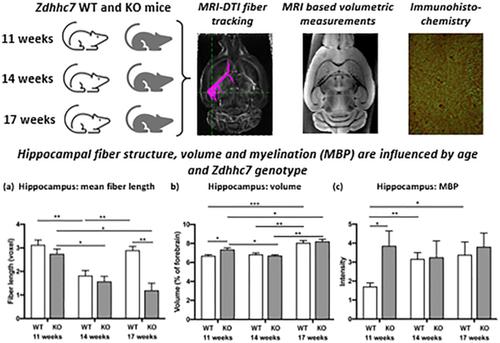当前位置:
X-MOL 学术
›
Eur. J. Neurosci.
›
论文详情
Our official English website, www.x-mol.net, welcomes your
feedback! (Note: you will need to create a separate account there.)
Brain microstructural changes in mice persist in adulthood and are modulated by the palmitoyl acyltransferase ZDHHC7
European Journal of Neuroscience ( IF 2.7 ) Pub Date : 2021-08-06 , DOI: 10.1111/ejn.15415 Nicole Kerkenberg 1, 2 , Lydia Wachsmuth 3 , Mingyue Zhang 1 , Christiane Schettler 1 , Evgeni Ponimaskin 4 , Cornelius Faber 2, 3 , Bernhard T. Baune 1, 2, 5, 6 , Weiqi Zhang 1, 2 , Christa Hohoff 1
European Journal of Neuroscience ( IF 2.7 ) Pub Date : 2021-08-06 , DOI: 10.1111/ejn.15415 Nicole Kerkenberg 1, 2 , Lydia Wachsmuth 3 , Mingyue Zhang 1 , Christiane Schettler 1 , Evgeni Ponimaskin 4 , Cornelius Faber 2, 3 , Bernhard T. Baune 1, 2, 5, 6 , Weiqi Zhang 1, 2 , Christa Hohoff 1
Affiliation

|
For a long time, mice have been classified as adults with completely mature brains at 8 weeks of age, but recent research suggests that developmental brain changes occur for up to 6 months. In particular, adolescence coincides with dramatic changes of neuronal structure and function in the brain that influence the connectivity between areas like hippocampus and medial prefrontal cortex (mPFC). Neuronal development and plasticity are regulated in part by the palmitoyl acyltransferase ZDHHC7, which modulates structural connectivity between hippocampus and mPFC. The aim of the current study was to investigate whether developmental changes take place in hippocampus and mPFC microstructure even after 8 weeks of age and whether deficiency of ZDHHC7 impacts such age-dependent alterations. Altogether, 46 mice at 11, 14 or 17 weeks of age with a genetic Zdhhc7 knockout (KO) or wild type (WT) were analysed with neuroimaging and diffusion tensor-based fibre tractography. The hippocampus and mPFC regions were compared regarding fibre metrics, supplemented by volumetric and immunohistological analyses of the hippocampus. In WT animals, we identified age-dependent changes in hippocampal fibre lengths that followed a U-shaped pattern, whereas in mPFC, changes were linear. In Zdhhc7-deficient animals, the fibre statistics were reduced in both regions, whereas the hippocampus volume and the intensities of myelin and neurofilament were higher in 11-week-old KO mice compared to WTs. Our results confirmed ongoing changes of microstructure in mice up to 17 weeks old and demonstrate that deleting the Zdhhc7 gene impairs fibre development, suggesting that palmitoylation is important in this process.
中文翻译:

小鼠的脑微结构变化在成年期持续存在,并受棕榈酰酰基转移酶 ZDHHC7 的调节
长期以来,小鼠被归类为大脑在 8 周龄时完全成熟的成年人,但最近的研究表明,大脑发育变化长达 6 个月。特别是,青春期与大脑中神经元结构和功能的巨大变化相吻合,这些变化会影响海马和内侧前额叶皮层 (mPFC) 等区域之间的连接。神经元发育和可塑性部分受棕榈酰酰基转移酶 ZDHHC7 的调节,该酶调节海马和 mPFC 之间的结构连接。本研究的目的是调查即使在 8 周龄后海马体和 mPFC 微观结构是否发生发育变化,以及 ZDHHC7 的缺乏是否会影响这种与年龄相关的变化。总共有 46 只 11、14 或 17 周龄的小鼠Zdhhc7敲除 (KO) 或野生型 (WT) 使用神经影像学和基于扩散张量的纤维束成像进行分析。比较海马和 mPFC 区域的纤维指标,并辅以海马的体积和免疫组织学分析。在 WT 动物中,我们发现海马纤维长度的年龄依赖性变化遵循 U 形模式,而在 mPFC 中,变化是线性的。在Zdhhc7 缺陷动物中,两个区域的纤维统计数据均减少,而 11 周龄 KO 小鼠的海马体积以及髓鞘和神经丝的强度高于 WT。我们的结果证实了长达 17 周龄的小鼠微观结构的持续变化,并证明删除Zdhhc7 基因损害纤维发育,表明棕榈酰化在此过程中很重要。
更新日期:2021-09-21
中文翻译:

小鼠的脑微结构变化在成年期持续存在,并受棕榈酰酰基转移酶 ZDHHC7 的调节
长期以来,小鼠被归类为大脑在 8 周龄时完全成熟的成年人,但最近的研究表明,大脑发育变化长达 6 个月。特别是,青春期与大脑中神经元结构和功能的巨大变化相吻合,这些变化会影响海马和内侧前额叶皮层 (mPFC) 等区域之间的连接。神经元发育和可塑性部分受棕榈酰酰基转移酶 ZDHHC7 的调节,该酶调节海马和 mPFC 之间的结构连接。本研究的目的是调查即使在 8 周龄后海马体和 mPFC 微观结构是否发生发育变化,以及 ZDHHC7 的缺乏是否会影响这种与年龄相关的变化。总共有 46 只 11、14 或 17 周龄的小鼠Zdhhc7敲除 (KO) 或野生型 (WT) 使用神经影像学和基于扩散张量的纤维束成像进行分析。比较海马和 mPFC 区域的纤维指标,并辅以海马的体积和免疫组织学分析。在 WT 动物中,我们发现海马纤维长度的年龄依赖性变化遵循 U 形模式,而在 mPFC 中,变化是线性的。在Zdhhc7 缺陷动物中,两个区域的纤维统计数据均减少,而 11 周龄 KO 小鼠的海马体积以及髓鞘和神经丝的强度高于 WT。我们的结果证实了长达 17 周龄的小鼠微观结构的持续变化,并证明删除Zdhhc7 基因损害纤维发育,表明棕榈酰化在此过程中很重要。











































 京公网安备 11010802027423号
京公网安备 11010802027423号